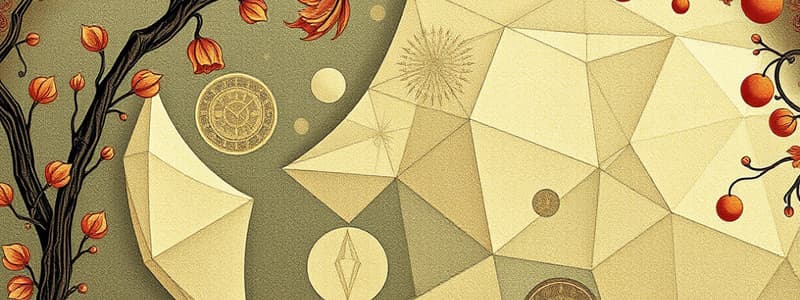Podcast
Questions and Answers
What is a hierarchy?
What is a hierarchy?
- An order or arrangement of objects based on the relationships among their characteristics (correct)
- A type of angle
- A shape with four equal sides
- A closed figure with no sides
What is an angle?
What is an angle?
A figure formed by two rays or lines that share a common endpoint.
What are vertices?
What are vertices?
The points at which two lines meet and form an angle.
Parallel lines are two lines that never touch.
Parallel lines are two lines that never touch.
What is a right angle?
What is a right angle?
What is an acute angle?
What is an acute angle?
What is an obtuse angle?
What is an obtuse angle?
What are two-dimensional figures?
What are two-dimensional figures?
What defines a polygon?
What defines a polygon?
What is a parallelogram?
What is a parallelogram?
What is a quadrilateral?
What is a quadrilateral?
What defines a trapezoid?
What defines a trapezoid?
What are the characteristics of a rectangle?
What are the characteristics of a rectangle?
What is a square?
What is a square?
What is a triangle?
What is a triangle?
What is a rhombus?
What is a rhombus?
What is a degree?
What is a degree?
What defines an isosceles triangle?
What defines an isosceles triangle?
What is an equilateral triangle?
What is an equilateral triangle?
What is a right triangle?
What is a right triangle?
What defines a scalene triangle?
What defines a scalene triangle?
What is an acute triangle?
What is an acute triangle?
What is an obtuse triangle?
What is an obtuse triangle?
What is a regular polygon?
What is a regular polygon?
What defines an irregular polygon?
What defines an irregular polygon?
What does congruent mean?
What does congruent mean?
Flashcards are hidden until you start studying
Study Notes
Geometry Terms and Definitions
- Hierarchy: An arrangement of objects based on the relationships among their characteristics.
- Angle: Formed by two rays or lines sharing a common endpoint.
- Vertices (Vertex): The meeting point of two lines, creating an angle.
- Parallel Lines: Lines that never intersect, maintaining equal distance apart.
- Right Angle: Measures exactly 90 degrees, forming a perfect corner.
- Acute Angle: An angle measuring less than 90 degrees.
- Obtuse Angle: An angle measuring more than 90 degrees.
Two-Dimensional Figures
- Two-Dimensional Figures: Flat shapes characterized by only length and width, lacking depth.
- Polygon: A closed figure with at least three straight sides.
- Parallelogram: A four-sided shape (quadrilateral) with two pairs of parallel sides.
- Quadrilateral: Any four-sided figure.
- Trapezoid: A four-sided figure with one pair of parallel sides.
Specific Types of Polygons
- Rectangle: A quadrilateral with four right angles, where opposite sides are equal and parallel.
- Square: A special type of rectangle with four equal sides and four right angles.
- Triangle: A three-sided figure with varying properties depending on its side lengths and angles.
Triangle Classifications
- Rhombus: All four sides are of equal length, with opposite angles being equal.
- Isosceles Triangle: A triangle with two equal sides and angles.
- Equilateral Triangle: A triangle where all three sides and angles are equal (60 degrees each).
- Right Triangle: Contains one angle that measures 90 degrees.
- Scalene Triangle: A triangle with no equal sides or angles.
- Acute Triangle: All three angles measure less than 90 degrees.
- Obtuse Triangle: Contains one angle that exceeds 90 degrees.
Other Geometry Concepts
- Regular Polygon: A closed figure with sides and angles that are all congruent.
- Irregular Polygon: A closed figure with no sides or angles that are congruent.
- Congruent: Refers to sides or angles that are of equal measure.
- Degree: A unit used to quantify the size of angles.
Studying That Suits You
Use AI to generate personalized quizzes and flashcards to suit your learning preferences.




